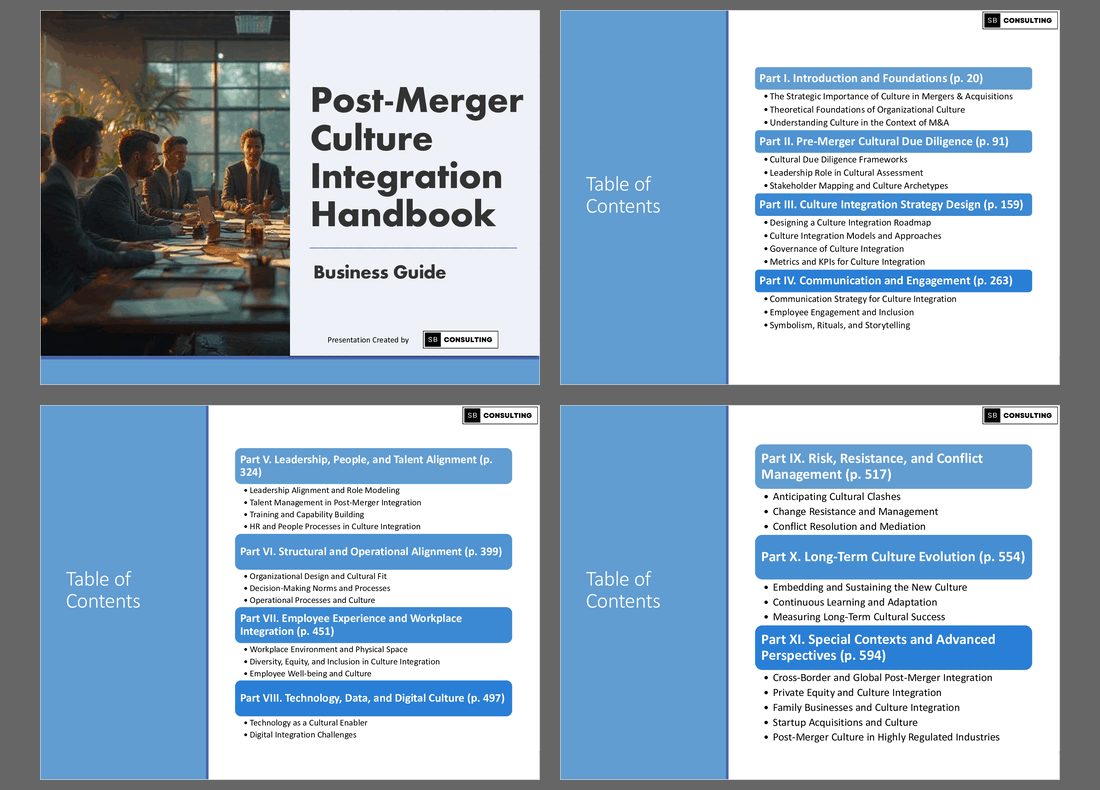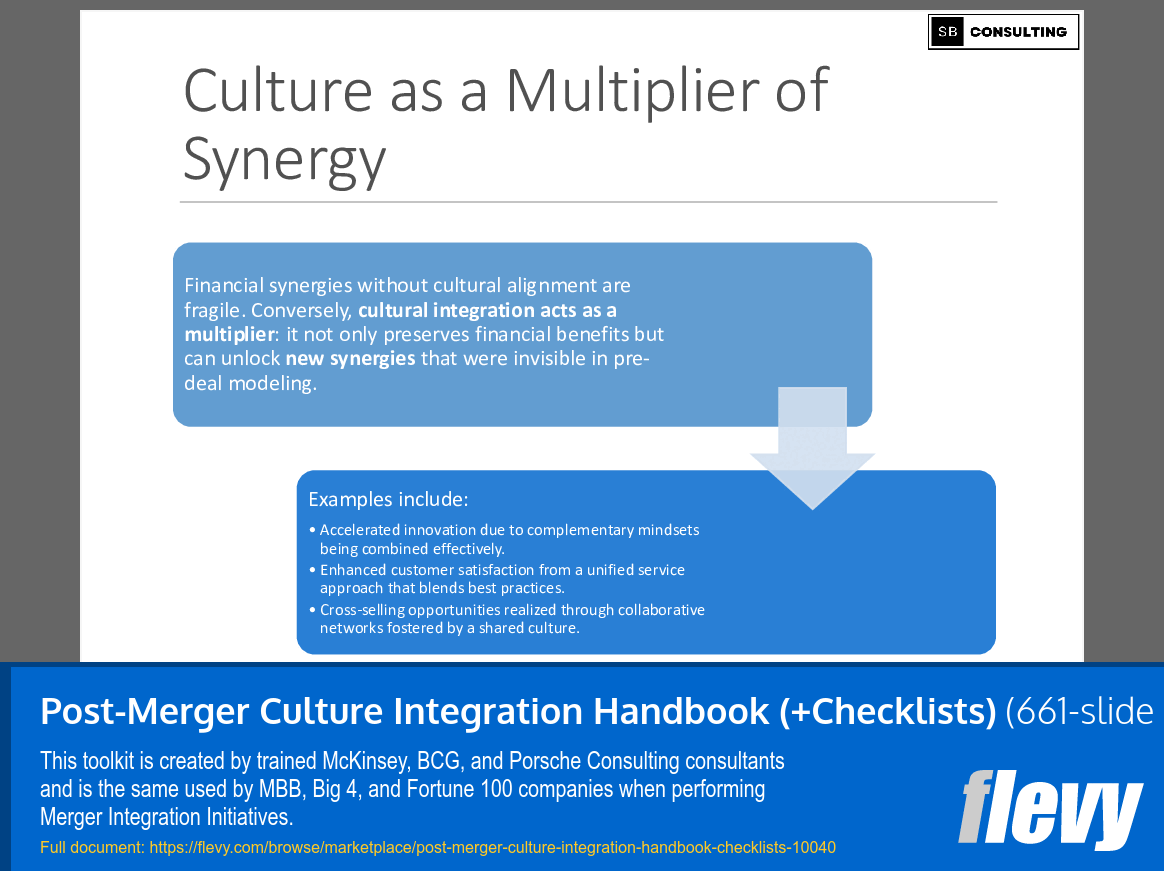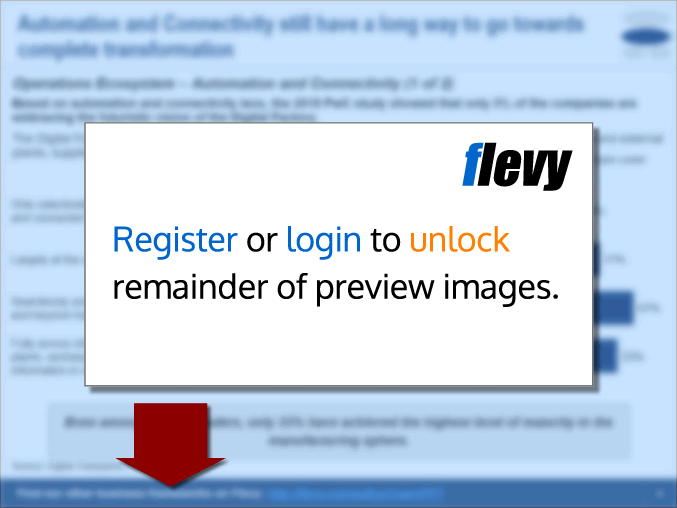Post-Merger Culture Integration Handbook (+Checklists) (PowerPoint PPTX Slide Deck)
PowerPoint (PPTX) 661 Slides
BENEFITS OF THIS POWERPOINT DOCUMENT
- Provides a framework for designing a Post-Merger Culture Integration Strategy that ensures lasting organizational alignment.
- Offers actionable tools and metrics to assess, monitor, and sustain cultural health throughout the integration process.
- Guides leaders in aligning talent, leadership, and communication practices to drive successful M&A outcomes.
PMI PPT DESCRIPTION
Curated by McKinsey-trained Executives
Unlock the Secret to Post-Merger Success with the Ultimate Culture Integration Handbook
In today's high-stakes mergers and acquisitions, the difference between a deal that thrives and one that fails often comes down to something many executives overlook: organizational culture. Financial projections, cost synergies, and market strategies are crucial—but without a deep, actionable understanding of culture, even the most promising mergers can falter. The Complete Post-Merger Culture Integration Handbook is your essential guide to ensuring that your next M&A transaction achieves its full potential.
This comprehensive handbook equips leaders, HR professionals, and integration teams with the strategies, tools, and frameworks necessary to align cultures seamlessly, drive employee engagement, and safeguard deal value. It dives into every aspect of culture integration, from pre-merger cultural due diligence to long-term culture evolution, ensuring that your organization not only survives the merger—but thrives.
Gain the competitive edge by learning how to identify cultural red flags before closing, integrate leadership and talent effectively, and harmonize structural, operational, and digital systems to reinforce the desired culture. With this handbook, you'll master the art of communication, engagement, and symbolic leadership to create trust, alignment, and a shared sense of purpose across newly combined organizations.
Whether you're navigating cross-border mergers, private equity acquisitions, startup integrations, or family business transitions, this handbook provides tailored strategies to manage cultural complexity, resistance, and conflict. It also includes actionable checklists and KPIs that allow you to measure cultural health, track progress, and continuously refine your integration approach—transforming culture from a potential risk into a dynamic competitive advantage.
Stop leaving culture to chance. The Complete Post-Merger Culture Integration Handbook is the definitive, must-have resource for executives, integration leaders, and HR professionals committed to driving post-merger success. Achieve higher retention, stronger employee engagement, and long-term organizational performance by mastering the science and art of culture integration today.
CONTENT OVERVIEW
Part I. Introduction and Foundations
1. The Strategic Importance of Culture in Mergers & Acquisitions
• Defining post-merger culture integration
• Why culture matters more than synergy math
• The link between culture and deal success/failure
2. Theoretical Foundations of Organizational Culture
• Key cultural models (Schein, Hofstede, Trompenaars, Competing Values Framework)
• National vs. organizational culture dynamics
• Subcultures and microcultures in organizations
3. Understanding Culture in the Context of M&A
• The nature of cultural collisions
• Power, politics, and hidden dynamics
• How culture amplifies or undermines synergies
• Culture as an asset vs. culture as a risk
________________________________________
Part II. Pre-Merger Cultural Due Diligence
4. Cultural Due Diligence Frameworks
• Dimensions of cultural assessment
• Tools, surveys, and diagnostic models
• Red flags and deal-breakers
5. Leadership Role in Cultural Assessment
• Executive alignment on culture priorities
• CEO, CHRO, and deal team responsibilities
• Integrating culture into valuation and negotiations
6. Stakeholder Mapping and Culture Archetypes
• Identifying cultural champions and blockers
• Understanding employee sentiment and readiness
• Archetypal corporate cultures (control, collaboration, innovation, performance)
________________________________________
Part III. Culture Integration Strategy Design
7. Designing a Culture Integration Roadmap
• Principles of effective culture integration
• Integration vs. assimilation vs. coexistence
• Defining the desired "new culture"
8. Culture Integration Models and Approaches
• Best-of-both, absorption, transformation, hybrid models
• Criteria for choosing an integration model
• The role of corporate identity and brand in integration
9. Governance of Culture Integration
• Establishing culture integration committees
• Defining decision rights and accountability
• Role of steering groups, PMOs, and integration management offices
10. Metrics and KPIs for Culture Integration
• Qualitative vs. quantitative cultural metrics
• Engagement, retention, performance indicators
• Linking culture metrics to deal objectives
________________________________________
Part IV. Communication and Engagement
11. Communication Strategy for Culture Integration
• Building trust through transparent communication
• Channels, cadence, and messaging tone
• Avoiding misalignment and rumor culture
12. Employee Engagement and Inclusion
• Creating feedback loops and listening forums
• Addressing uncertainty, fear, and resistance
• Building psychological safety in the transition
13. Symbolism, Rituals, and Storytelling
• The power of symbolic acts in culture integration
• Leveraging corporate narratives and shared stories
• Designing rituals and traditions for the new culture
________________________________________
Part V. Leadership, People, and Talent Alignment
14. Leadership Alignment and Role Modeling
• The leader as a culture carrier
• Executive behavioral alignment with desired culture
• Leadership archetypes in post-merger contexts
15. Talent Management in Post-Merger Integration
• Identifying key talent and retention risks
• Redesigning career paths and growth opportunities
• Aligning incentives, rewards, and recognition systems
16. Training and Capability Building
• Cross-cultural training programs
• Change management skills development
• Leadership coaching and mentoring for integration
17. HR and People Processes in Culture Integration
• Performance management alignment
• Recruitment and onboarding in the new culture
• Redesigning HR policies and practices
________________________________________
Part VI. Structural and Operational Alignment
18. Organizational Design and Cultural Fit
• Aligning structure with cultural priorities
• Balancing centralization vs. decentralization
• New roles and reporting lines
19. Decision-Making Norms and Processes
• Governance norms in the new entity
• Balancing speed vs. consensus
• Creating shared decision-making rituals
20. Operational Processes and Culture
• Embedding culture in daily operations
• Aligning process discipline with cultural values
• Digital tools and workflow systems as culture enablers
________________________________________
Part VII. Employee Experience and Workplace Integration
21. Workplace Environment and Physical Space
• Offices, symbols, and artifacts of culture
• Designing collaborative vs. hierarchical spaces
• Remote and hybrid work in post-merger contexts
22. Diversity, Equity, and Inclusion in Culture Integration
• M&A as an opportunity to strengthen DEI
• Addressing bias and inclusion challenges
• Building cultural belonging in a diverse workforce
23. Employee Well-being and Culture
• Managing stress and uncertainty
• Mental health and resilience initiatives
• Burnout prevention in integration periods
________________________________________
Part VIII. Technology, Data, and Digital Culture
24. Technology as a Cultural Enabler
• Collaboration platforms and digital culture
• Aligning IT systems and employee experience
• Data transparency and decision-making norms
25. Digital Integration Challenges
• Merging digital ecosystems
• Cybersecurity norms and digital trust
• Balancing legacy systems and new technologies
________________________________________
Part IX. Risk, Resistance, and Conflict Management
26. Anticipating Cultural Clashes
• Identifying cultural hot spots
• Managing power struggles and turf wars
• National cultural conflict in cross-border deals
27. Change Resistance and Management
• Sources of resistance in post-merger settings
• Strategies for overcoming pushback
• Building adaptability into cultural transformation
28. Conflict Resolution and Mediation
• Tools for cultural conflict resolution
• Role of mediators and facilitators
________________________________________
Part X. Long-Term Culture Evolution
29. Embedding and Sustaining the New Culture
• Institutionalizing norms, values, and behaviors
• Continuous reinforcement mechanisms
• Celebrating milestones and success stories
30. Continuous Learning and Adaptation
• Feedback and learning systems
• Adapting culture over time as the business evolves
• Culture as a dynamic competitive advantage
31. Measuring Long-Term Cultural Success
• Cultural health indexes
• Linking culture to performance and innovation
• Benchmarking against peers and industry leaders
________________________________________
Part XI. Special Contexts and Advanced Perspectives
32. Cross-Border and Global Post-Merger Integration
• Navigating national cultural differences
• Multi-jurisdictional culture integration challenges
• Global-local culture harmonization
33. Private Equity and Culture Integration
• Short time horizons vs. sustainable culture
• Balancing financial engineering and people priorities
• Exit strategies and culture considerations
34. Family Businesses and Culture Integration
• Legacy values and heritage preservation
• Intergenerational dynamics in post-merger settings
• Emotional ownership and identity challenges
35. Startup Acquisitions and Culture
• Integrating entrepreneurial and corporate cultures
• Avoiding innovation suffocation
• Preserving agility while scaling operations
36. Post-Merger Culture in Highly Regulated Industries
• Banking, healthcare, pharma, defense context
• Compliance-driven vs. innovation-driven cultures
• Aligning ethics, governance, and culture
Checklists
• Leadership Alignment Assessment
• Vision and Mission Integration
• Core Values Alignment
• Cultural Due Diligence Review
• Employee Engagement Strategy
• Change Management Planning
• Communication Strategy and Cadence
• Stakeholder Mapping and Prioritization
• Talent Retention Risk Assessment
• Onboarding and Orientation Program
• Performance Management Harmonization
• Reward and Recognition Alignment
• Organizational Structure Integration
• Team Norms and Collaboration Guidelines
• Decision-Making Process Alignment
• Conflict Resolution Mechanisms
• Diversity, Equity, and Inclusion Integration
• Knowledge Transfer and Best Practices Sharing
• Employee Feedback and Pulse Surveys
• Training and Development Planning
• Cultural Metrics and KPIs Definition
• Cross-Functional Collaboration Initiatives
• Communication of Successes and Wins
• Monitoring and Continuous Improvement Plan
• Post-Integration Cultural Health Audit
Secure your copy now and ensure your next merger delivers the value it promises—because in M&A, culture isn't just a factor; it's the difference between success and failure.
Key Words:
Strategy & Transformation, Growth Strategy, Strategic Planning, Strategy Frameworks, Innovation Management, Pricing Strategy, Core Competencies, Strategy Development, Business Transformation, Marketing Plan Development, Product Strategy, Breakout Strategy, Competitive Advantage, Mission, Vision, Values, Strategy Deployment & Execution, Innovation, Vision Statement, Core Competencies Analysis, Corporate Strategy, Product Launch Strategy, BMI, Blue Ocean Strategy, Breakthrough Strategy, Business Model Innovation, Business Strategy Example, Corporate Transformation, Critical Success Factors, Customer Segmentation, Customer Value Proposition, Distinctive Capabilities, Enterprise Performance Management, KPI, Key Performance Indicators, Market Analysis, Market Entry Example, Market Entry Plan, Market Intelligence, Market Research, Market Segmentation, Market Sizing, Marketing, Michael Porter's Value Chain, Organizational Transformation, Performance Management, Performance Measurement, Platform Strategy, Product Go-to-Market Strategy, Reorganization, Restructuring, SWOT, SWOT Analysis, Service 4.0, Service Strategy, Service Transformation, Strategic Analysis, Strategic Plan Example, Strategy Deployment, Strategy Execution, Strategy Frameworks Compilation, Strategy Methodologies, Strategy Report Example, Value Chain, Value Chain Analysis, Value Innovation, Value Proposition, Vision Statement, Corporate Strategy, Business Development, Busienss plan pdf, business plan, PDF, Biusiness Plan DOC, Bisiness Plan Template, PPT, Market strategy playbook, strategic market planning, competitive analysis tools, market segmentation frameworks, growth strategy templates, product positioning strategy, market execution toolkit, strategic alignment playbook, KPI and OKR frameworks, business growth strategy guide, cross-functional strategy templates, market risk management, market strategy PowerPoint dec, guide, ebook, e-book ,McKinsey Change Playbook, Organizational change management toolkit, Change management frameworks 2025, Influence model for change, Change leadership strategies, Behavioral change in organizations, Change management PowerPoint templates, Transformational leadership in change, supply chain KPIs, supply chain KPI toolkit, supply chain PowerPoint template, logistics KPIs, procurement KPIs, inventory management KPIs, supply chain performance metrics, manufacturing KPIs, supply chain dashboard, supply chain strategy KPIs, reverse logistics KPIs, sustainability KPIs in supply chain, financial supply chain KPIs, warehouse KPIs, digital supply chain KPIs, 1200 KPIs, supply chain scorecard, KPI examples, supply chain templates
NOTE: Our digital products are sold on an "as is" basis, making returns and refunds unavailable post-download. Please preview and inquire before purchasing. Please contact us before purchasing if you have any questions! This policy aligns with the standard Flevy Terms of Usage.
Got a question about the product? Email us at support@flevy.com or ask the author directly by using the "Ask the Author a Question" form. If you cannot view the preview above this document description, go here to view the large preview instead.
Source: Best Practices in PMI, Corporate Culture PowerPoint Slides: Post-Merger Culture Integration Handbook (+Checklists) PowerPoint (PPTX) Presentation Slide Deck, SB Consulting









